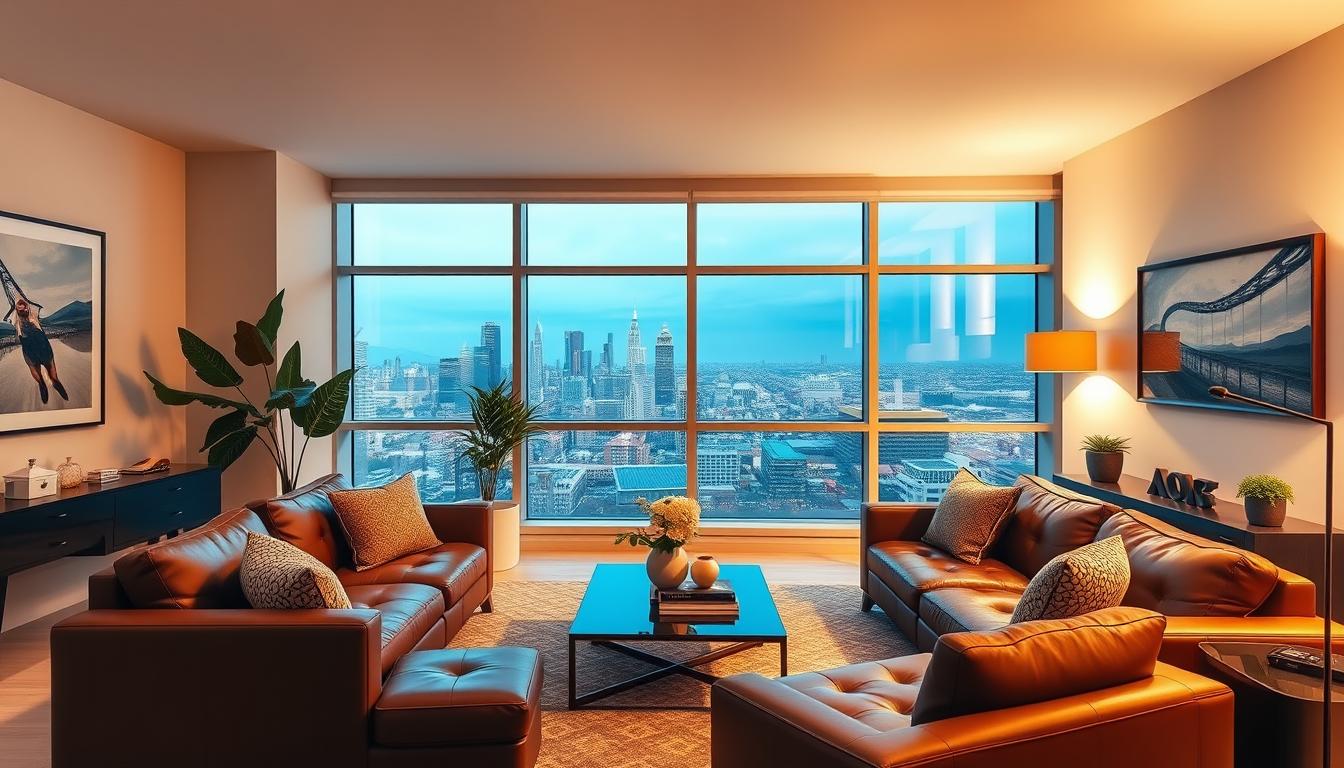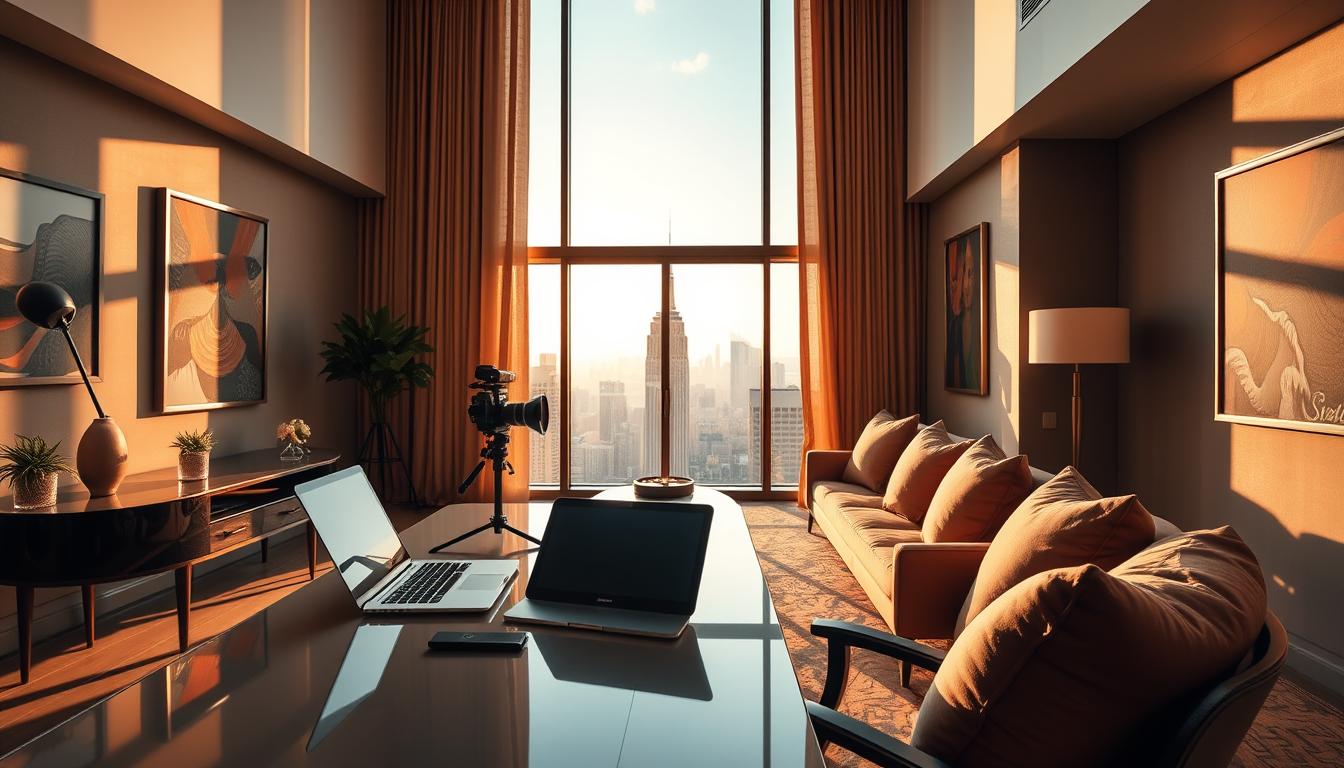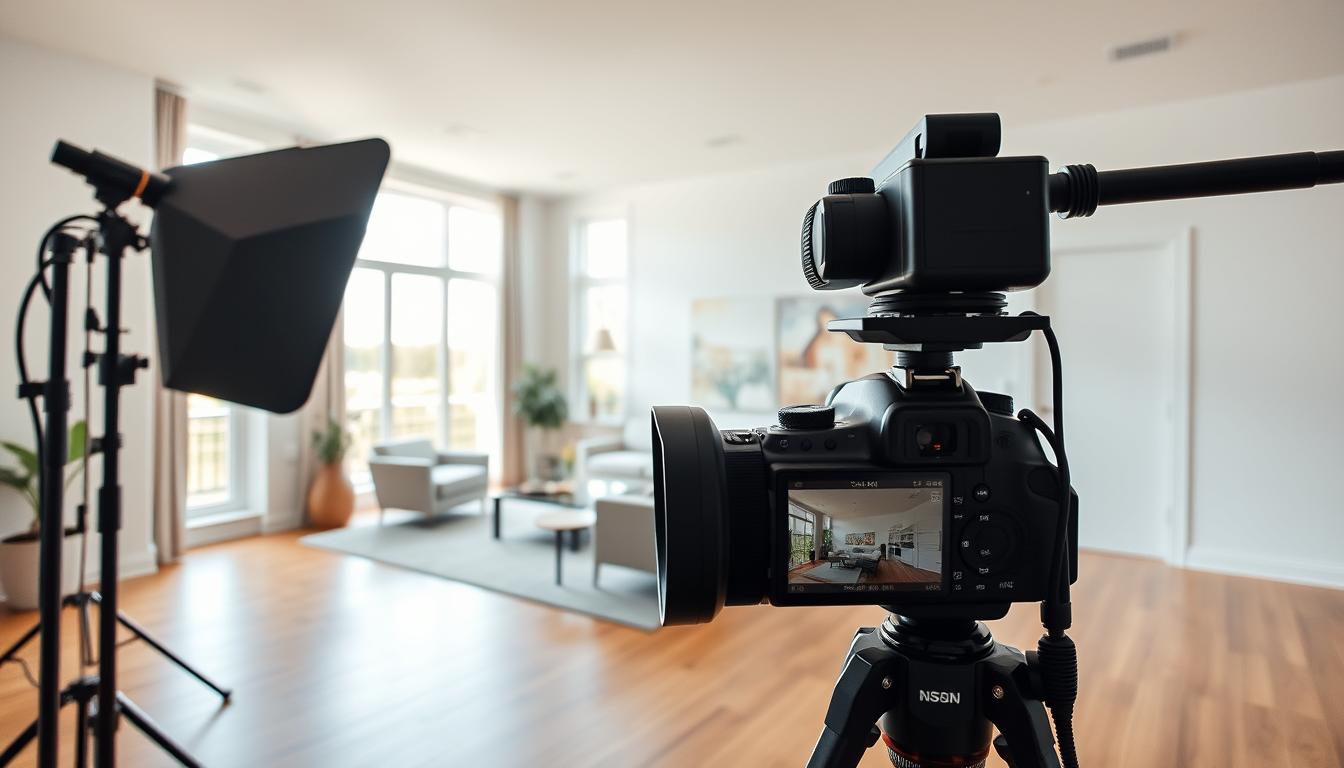In today’s real estate market, showing properties well is key. Virtual staging is a big help. It lets sellers show off properties with great designs without needing to stage them physically.
This new way of property staging makes listings look better. It also lets buyers imagine living there. So, virtual staging is now a must in real estate marketing. It helps properties get noticed and attract more buyers.
Real estate pros can make their listings more appealing with virtual staging. It’s a smart move in our digital world.
What is Virtual Staging?
Virtual staging is changing the real estate world. It’s a digital way to make properties look great without using real furniture. This method lets real estate folks show off homes in the best way possible.
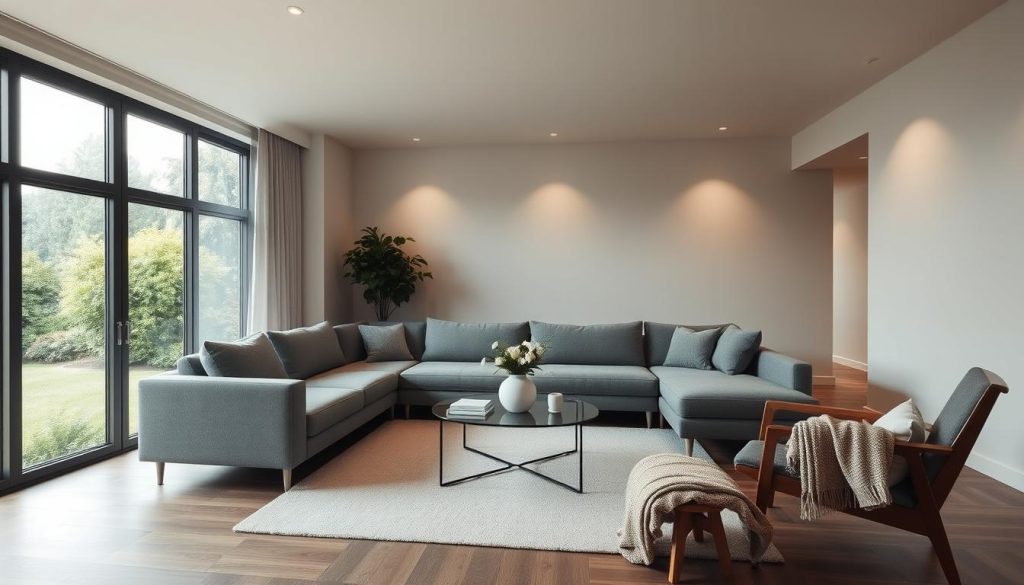
Definition and Technology Behind Virtual Staging
Virtual staging, or digital staging, uses special software and photos to make empty spaces look good. It works by adding furniture and decor to pictures of homes. This makes homes look welcoming to people who might buy them.
Evolution of Virtual Staging in Real Estate
Virtual staging has grown a lot over time. It started slow, but better technology made it more popular. Now, it’s seen as a great way to market homes.
It’s cheaper and easier to use than old ways. This makes it a big help in a busy market.
The Benefits of Virtual Staging for Real Estate Listings
In the world of real estate, virtual staging is a big help. It gives sellers an edge. It makes listings better for sellers and buyers.
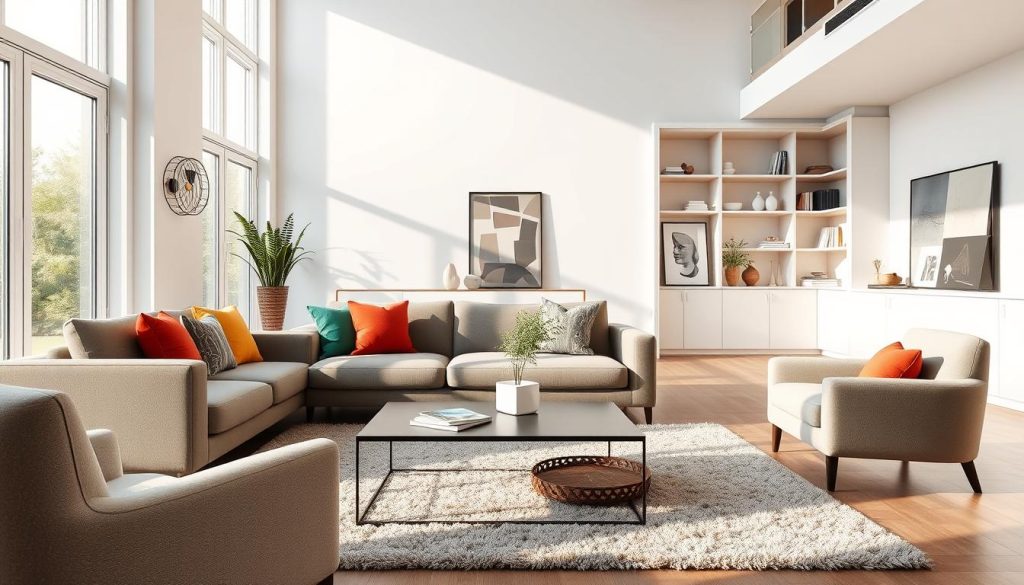
Statistical Impact on Listing Performance
Studies show virtual staging boosts listing performance. It does this in two main ways:
Reduced Days on Market
Properties with virtual staging images sell quicker. This is because they look more inviting. Buyers make decisions faster.
Higher Engagement Metrics
Virtual staged photos get more attention. Buyers like to see clear, welcoming spaces. This makes them remember listings better.
Buyer Perception and Visualization
Virtual staging helps buyers see a property’s full promise. It shows a furnished space. This helps buyers feel a connection to the property.
Seller Advantages and Cost Savings
Sellers save money and get more exposure with virtual staging. It’s cheaper than real staging. It shows properties in their best light without needing real furniture.
Advantages for sellers include:
- Cost savings on physical staging
- Increased property appeal
- Faster sale times
Virtual staging helps sellers get more value. It saves money upfront.
Virtual vs. Traditional Staging: A Comparative Look
In real estate marketing, the debate between virtual and traditional staging is growing. Sellers and agents seek the best ways to show properties. Knowing the differences between these two methods is key.
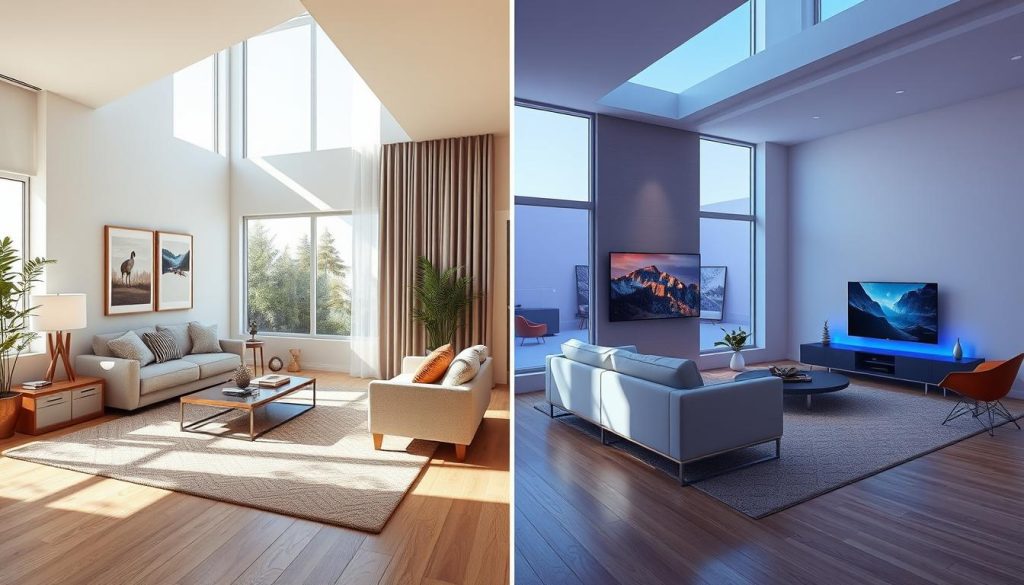
Cost Analysis and ROI
Cost is a big factor in choosing between virtual and traditional staging. Virtual staging is often cheaper, costing $100 to $500 per image. Traditional staging can cost $1,000 to $5,000 or more, based on the property size and staging time.
The ROI for virtual staging is high. It can make a property look better online, possibly increasing its sale price.
Time Investment and Turnaround
Time is also important. Traditional staging takes days to a week, depending on the property and the staging company’s schedule. Virtual staging can be done in 24 to 48 hours. This makes it great for quick listings.
Flexibility and Customization Options
Virtual staging is very flexible and customizable. It’s easy to change styles, furniture, and colors to attract different buyers. This is hard and expensive with traditional staging. Sellers can try many virtual staging designs to find the best one.
The Virtual Staging Process Explained
The journey of virtual staging starts with taking photos of the property. This first step is key. It sets the stage for the whole process. Good photos make the virtual staging look real and nice.
Professional Photography Requirements
Getting good photos is the first thing in virtual staging. It needs knowing about light, angles, and getting the room ready. This makes the property look its best.
Lighting and Angle Considerations
Lighting and camera angles are very important. Natural light is best. Photographers often take pictures from corners or use wide-angle lenses to show more of the room.
Room Preparation Tips
Before taking photos, rooms should be clean and free of personal stuff. Taking out things you don’t need and fixing small things can make the photos better.
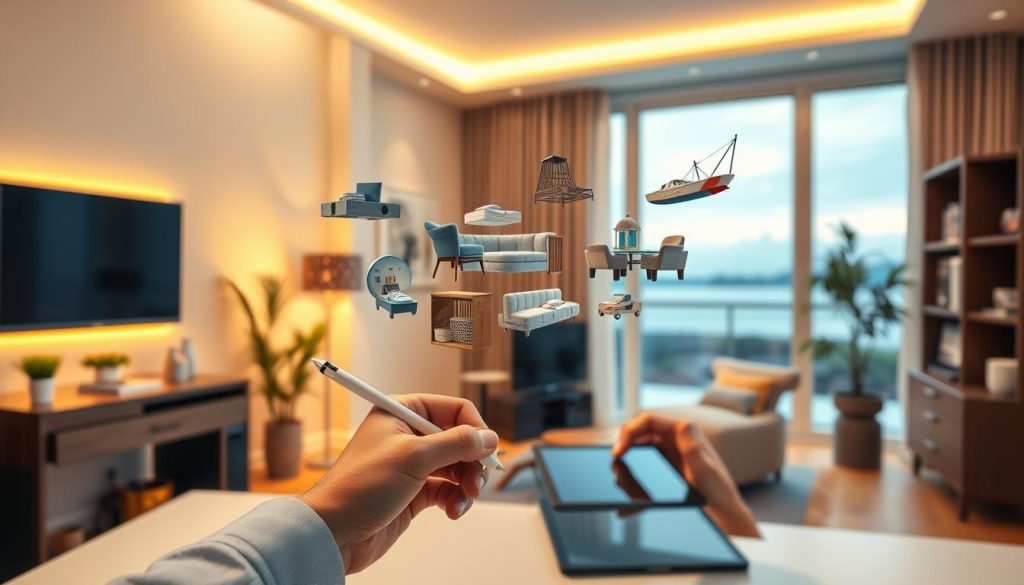
Design Selection and Style Considerations
After taking photos, picking the design and style comes next. This means choosing furniture, colors, and decor that people will like. The aim is to make the space feel welcoming. This helps buyers imagine living there.
Editing, Quality Control, and Delivery
The last step is editing the photos to add the design choices. Checking the quality makes sure the images look real and good. Then, the photos are given to the client for marketing.
Knowing and following the virtual staging process helps real estate pros make their listings better. This can attract more buyers.
Implementing Virtual Staging for Real Estate Listings
Using virtual staging in real estate listings needs careful steps. Real estate pros must pick the right properties, find a good virtual staging service, and use staged images well in marketing.
Identifying Properties That Benefit Most
Not every property is right for virtual staging. Vacant or unfurnished properties work best, as it lets buyers see the space. Also, properties with special layouts or hard-to-stage areas get a big boost.
- Vacant or unfurnished homes
- Properties with unique architectural features
- Homes with high-end finishes that need to be highlighted
Selecting the Right Virtual Staging Partner
Finding the right virtual staging partner is key. Look for ones with high-quality images, lots of design choices, and fast service. It’s good to pick a partner who knows your market well.
Integrating Virtual Staging into Marketing Strategy
Virtual staging must fit into your marketing plan. Use staged images in MLS listings, on social media, and in digital ads.
MLS Listing Best Practices
When listing a staged property on the MLS, say it’s staged. This is honest and follows rules.
Social Media and Digital Marketing Applications
Share before-and-after shots, point out design details, and use hashtags to get more views.
Best Practices for Effective Virtual Staging
To make virtual staging work well, follow some key steps. It makes properties look better and helps buyers see how they could use the space.
Maintaining Realism and Proportion
Keeping things real and right-sized is important. Make sure the furniture and decor fit the room and match the property’s style. Avoid overcrowding the space with too much furniture, as this can make the room appear smaller than it is.
- Use furniture that is proportional to the room size.
- Select decor that complements the property’s style.
- Ensure that the staging does not overwhelm the space.
Choosing Appropriate Styles for Target Markets
Knowing who you’re selling to is key. Different people like different looks. For example, young buyers might like modern styles, while families might prefer traditional.
Researching the preferences of your target audiencehelps pick the right look for your virtual staging.
Disclosure and Transparency with Buyers
Being open is very important in real estate. Make sure to say when pictures are staged, to avoid confusion. Clear disclosure builds trust and follows the rules of marketing.
- Clearly label virtually staged images.
- Provide information about the staging process.
- Ensure that the virtual staging aligns with the actual property features.
Common Virtual Staging Mistakes to Avoid
To make virtual staging work well, we must avoid common mistakes. These mistakes can stop people from wanting to buy a house. Virtual staging can make houses look better online, but some problems can mess it up.
Overcrowding Spaces
One big mistake is putting too much stuff in a room. This makes rooms look small and messy. Avoid using too many pieces and make the space feel welcoming.
For example, a living room should have a sofa, coffee table, and a few chairs. But not so many that it feels too tight.
Misrepresenting Property Features
Another mistake is showing things that aren’t real. Virtual staging should show off the house’s best parts, not lie about them. Accuracy is key to keep buyers trusting you.
For instance, if a room has a special design, show it off in the virtual staging. Don’t hide it.
Poor Quality Images and Execution
Bad pictures and poor virtual staging can hurt your efforts. Good pictures are important to show off the house well. Investing in professional photography and making sure the staging looks good can really help.
| Mistake | Impact | Solution |
|---|---|---|
| Overcrowding | Makes rooms appear smaller | Use balanced furniture arrangement |
| Misrepresentation | Loss of buyer trust | Ensure accuracy in staging |
| Poor Quality Images | Undermines staging effectiveness | Invest in professional photography |
Top Virtual Staging Tools and Services
In the world of real estate, virtual staging tools and services are changing how we show properties. They help sellers make their homes look great, drawing in more buyers. This can lead to more sales.
Professional Virtual Staging Services
For those who don’t want to do it themselves, there are professional services. These experts make property photos look better, making them more appealing to buyers.
Full-Service Providers
Companies like BoxBrownie and Stagelings offer everything you need. They handle photography, editing, and design. They help with simple or complex staging needs.
Specialized Virtual Stagers
Some virtual stagers focus on details like furniture or architecture. They add realism to the images, making them look better.
DIY Virtual Staging Software Options
For those who like to do things themselves, there’s DIY software. Tools like RoomSketcher and Planner 5D let you stage homes yourself. They have easy-to-use interfaces and lots of furniture options.
Pricing Models and What to Expect
Prices for virtual staging vary a lot. It depends on the service, how complex the work is, and how many images you need. On average, it can cost $50 to $200 per image. DIY software costs can vary, with options for subscriptions or one-time buys.
Conclusion
Virtual staging has changed the real estate world. It makes showing homes easy and affordable. This helps real estate pros attract more buyers and sell more homes.
Using virtual staging well can really help your listings. It makes homes look better in pictures. This is key as the real estate market keeps changing.
Follow the best ways to use virtual staging to avoid mistakes. It’s a great tool for anyone in real estate. It helps you market homes better and meet your sales goals.
FAQ
What is virtual staging, and how does it work?
Virtual staging uses digital tech to make empty rooms look good. It adds furniture and decor to photos. This makes rooms look inviting and appealing.
How does virtual staging benefit real estate listings?
It makes listings more interesting to buyers. It shows how a room could look. This can lead to more views and interest.
What are the advantages of virtual staging over traditional staging?
It’s cheaper and more flexible. You can try out different designs easily. It also saves on furniture and decor costs.
How do I choose the right virtual staging partner?
Look at their work and what others say. Choose someone who offers quality images and good prices. Make sure they know your market well.
What are some common mistakes to avoid in virtual staging?
Don’t make rooms too full or show things that aren’t there. Keep images real and appealing. Be honest with buyers.
How can I effectively integrate virtual staging into my marketing strategy?
Use staged images in your online listings and social media. Make sure they look good and fit your brand.
What are the pricing models for virtual staging services?
Prices vary by provider and project. You might pay per image or get a package deal. It depends on what you need.
Can I DIY virtual staging, or do I need to hire a professional?
You can try DIY tools, but a pro can do better. They save time and ensure quality. They also avoid mistakes.

